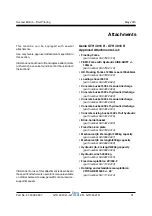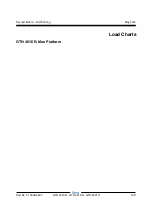
May 2015
94 GTH 4016 R - GTH 4018 R - GTH-5021 R Part No.
57.0009.0607
Second Edition - First Printing
Attachments
Suspended Load Hazards
Work Area Safety
General Safety
Do not lift a suspended load without first
understanding the local, state, federal, or
provincial rules, standards and regulations related
to the activity. Additional rules, standard and
regulations may apply. Additional training may be
required.
If a telehandler must be used to transport a load,
the following precautions for the protection of the
operator shall be taken.
Read, understand and obey all warnings and
instructions provided with the attachment that is
approved for suspending loads.
Only a properly designed, tested and approved
attachment should be used to carry a suspended
load.
The telehandler load charts are designed for
loads where the load center is stationary. As
a suspended load moves, the load center
can change. As a result, extreme caution in
transporting and lifting, or placing, the load must
be observed to minimize the potential for the load
to move.
Overturning Hazards
Do not lift a suspended load without the proper
and legible load capacity chart for the attachment/
telehandler combination you are using.
Do not permit
the load to swing
freely. Always
properly tether
loads to restrict
movement.
In addition
to ground
personnel, the
two chassis
lifting points
in the front of
the machine
can be used to
help externally
stabilize the
load. Always
cross the tethers
to opposite sides
of the load to
minimize load
movement.
Driving across
grades, sudden
starts, stops,
and turns can
cause the load
to swing and
create a hazard
if not externally
stabilized.
Keep the boom retracted as much as practical.
Do not lift suspended loads when wind speeds can
cause an unsafe situation.
All movements of the load must be accomplished
gradually and at the slowest practical speed to
prevent the load from swinging.
Содержание Genie GTH4016 SR
Страница 152: ... y B d e t u b i r t s i D www genielift com ...







































